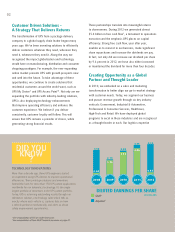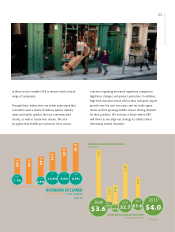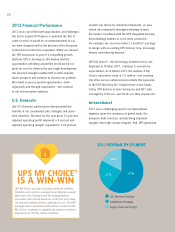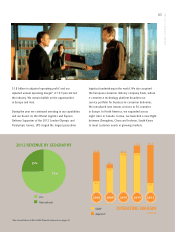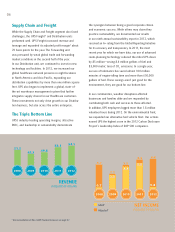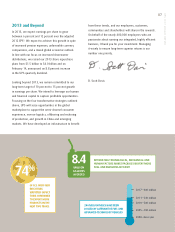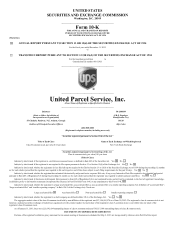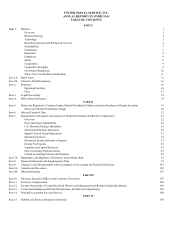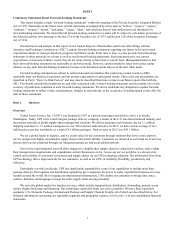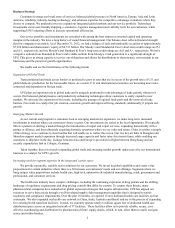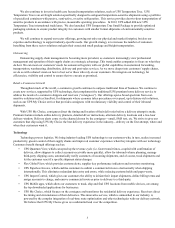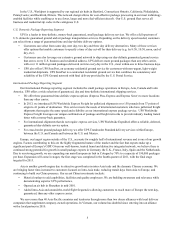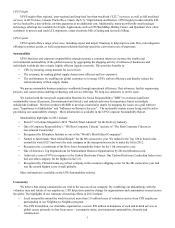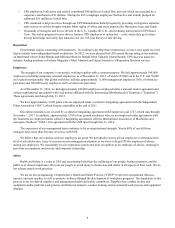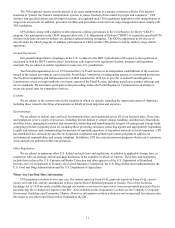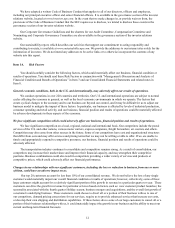UPS 2012 Annual Report Download - page 14
Download and view the complete annual report
Please find page 14 of the 2012 UPS annual report below. You can navigate through the pages in the report by either clicking on the pages listed below, or by using the keyword search tool below to find specific information within the annual report.2
Business Strategy
Customers leverage our broad array of services; balanced global presence in North America, Europe, Asia and Latin
America; reliability; industry-leading technology; and solutions expertise for competitive advantage in markets where they
choose to compete. We prudently invest to expand our integrated global network and our service portfolio. Technology
investments create user-friendly shipping, e-commerce, logistics management and visibility tools for our customers, while
supporting UPS’s ongoing efforts to increase operational efficiencies.
Our service portfolio and investments are rewarded with among the best returns on invested capital and operating
margins in the industry. We have a long history of sound financial management. Our balance sheet reflects financial strength
that few companies can match. As of December 31, 2012, we had a balance of cash and marketable securities of approximately
$7.924 billion and shareowners’ equity of $4.733 billion. Our Moody’s and Standard & Poor’s short-term credit ratings are P-1
and A-1, respectively, and our Moody’s and Standard & Poor’s long-term credit ratings are Aa3 and A+, respectively. We have
a negative outlook from Standard & Poor's and a stable outlook from Moody's. Cash generation is a significant strength of
UPS. This gives us strong capacity to service our obligations and allows for distributions to shareowners, reinvestment in our
businesses and the pursuit of growth opportunities.
We enable and are the beneficiaries of the following trends:
Expansion of Global Trade
Transcontinental and trade across borders is predicted to grow at rates that are in excess of the growth rates of U.S. and
global domestic production for the foreseeable future. As a result, U.S. and international economies are becoming more inter-
connected and dependent on foreign trade.
UPS plays an important role in global trade and is uniquely positioned to take advantage of trade growth, wherever it
occurs. Our balanced global presence and productivity enhancing technologies allow customers to easily expand to new
markets. We advocate the expansion of free trade, including the passage of regional trade pacts and the removal of trade
barriers. Free trade is a catalyst for job creation, economic growth and improved living standards; additionally, it propels our
growth.
Emerging Market Growth
As our current and prospective customers look to emerging markets for expansion, we make long-term, measured
investments in markets where our customers choose to grow. Our investments are scaled to the local opportunity. We typically
follow a pattern of entering a market through the introduction of import and export services, expanding domestically with a
partner or alliance, and then ultimately acquiring domestic operations where we see value and return. China is a prime example
of this strategy as we continue to clear hurdles that will enable us to realize this vision. Our two key air hubs in Shanghai and
Shenzhen support market expansion through increased cargo capacity and faster intra-Asia transit times, while enabling our
customers to ship later in the day. Linkage between Asia and Europe is provided via flights between Hong Kong and our
recently expanded air hub in Cologne, Germany.
Taken together, these two trends (expanding global trade and emerging market growth) underscore why our international
business is a catalyst for UPS’s growth.
Increasing need for segment expertise in the integrated carrier space
We provide repeatable, scalable sector solutions for our customers. We invest in global capabilities and create value
propositions for certain industries where there is a fit between our customers’ needs and our offerings. Segments where we
bring unique value propositions include health care, high-tech, automotive & industrial manufacturing, retail, government and
professional, and consumer services.
The health care industry faces complex challenges, including the continuing expiration of drug patents and the shifting
landscape of regulatory requirements and drug pricing controls that differ by country. To counter these threats, many
pharmaceutical companies have embarked on global expansion strategies that require infrastructure. UPS has aligned our
resources to serve these needs through a well-developed supply chain management capability that is designed to satisfy
regulatory and compliance requirements. Over the past 18 months, we opened 12 new dedicated health care facilities on four
continents. We also expanded our health care network in China, India, Australia and Brazil and are in the process of expanding
five existing North American facilities. In total, we currently operate nearly 6 million square feet of dedicated health care
distribution space across an integrated network of 37 facilities. These facilities allow us to provide reliable, secure, cost-
effective warehousing and distribution for pharmaceutical firms’ supply chains, which, in turn, allow them to easily navigate
across and within borders.


